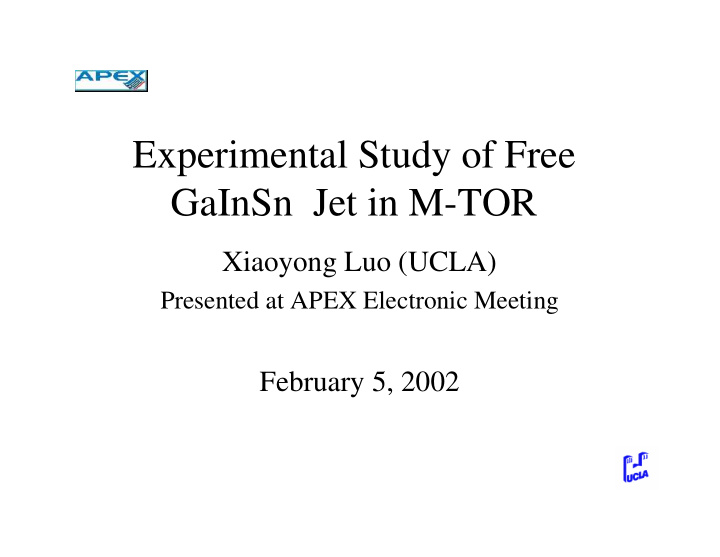



Experimental Study of Free GaInSn Jet in M-TOR Xiaoyong Luo (UCLA) Presented at APEX Electronic Meeting February 5, 2002
OUTLINE • Introduction • Experimental Facility • Description of Test Article • Magnetic Field of the Flux Concentrator • Numerical Simulation • Conclusions -1-
Experimental Facility Ga Inlet Flow Meter 1. Magnetic Torus Liquid Metal MHD flow test facility (MTOR) • 24 electromagnets arranged in a magnetic torus geometry, a 3400A/180V DC power Iron block supply, and a 16 liter actively pumped Ga-In- Concentrator Sn flow loop • At a maximum current of 3400A, the field strength is about 0.6T at inboard Circle disk Concentrator 2. A Magnetic field concentrator is Supporter added into the facility (M-TOR) to increase the local field strength 3. Flow meter diagnostic -2- Argon Gas Ga Outlet
Main Test Article Description 1. The test article is composed of 3 sections 5mm (1) A nozzle to provide a 5mm round jet Nozzle (2)A transparent enclosure to prevent Ga oxidation Transparent (3)A cone-shape receiver to minimize splashing area 2. Experiments have been conducted in two test articles configurations • a circular version • a rectangular version Cone- shape Unit: mm -3-
Flux Concentrator Assembly Iron Block • The concentrator assembly includes a pair of large iron Slots circle disks (not shown), which grasp the flux and redistribute it into a small iron block • The field strength depends on the distance between the pair Unit: mm -4-
Magnetic Field Strength inside the Flux Concentrator Maximum Point • The magnetic field increases as the current passing through the coils increases Maximum Gradient • A Gauss meter is used to measure the field strength at 7 locations • The maximum magnetic field is ~ 1.1T • The maximum gradient of the magnetic field is ~ 10T/m Note: Distance means distance away from the edge of the concentrator -5-
Video 1 for Round Test Article • Most of the view is blocked by the iron flux concentrator. Only flow outside the edge of the concentrator can be seen. • The Maximum Magnetic Field is ~ 1.1T( at the midplane of the concentrator) • A gradient exists between the inside and outside of the concentrator. A gradient of 33T/m is detected -6-
Video 2 for Rectangular Test Article • The Maximum Magnetic Field at the midplane is ~ 0.9T at 2600A • The gradient is ~ 10T/m • Slots were cut in the iron concentrator along the gradient region to provide jet deflection measurements • The jet location is indicated by the bright spot (jet can not be seen) -7-
Numerical Simulation • Governing Equations → ∂ Momentum → → → → → 1 U + ∇ = −∇ + ∆ + × ( U . ) U p U N ( j B ) Equation ∂ t Re Maxwell’s → ∂ → B Equations → → ∇ × = − E ∇ × = B j ∂ t Ohm’s Law → → → → conservation law → = σ + × j E U B ∇ ⋅ = 0 j Poisson Equation → → ∇ φ = ∇ ⋅ × 2 ( U B ) -8-
Numerical Simulation • Numerical Methods Key Points : (1) An iterative computation → → → − 1 1 to Ohm’s law was applied ∇ φ + = ∇ ⋅ × − ∇ ⋅ 2 1 n n n n U B 1 j σ ε and a Poisson equation of the scalar potential was → → → → adopted in the numerical + + = − ε + εσ −∇ φ + × n 1 n n 1 n n ( 1 ) ( ) j j U B procedure . (2) Two-order central → → difference scheme was + − n 1 n j j used. (3) VOF method was used Convergence critical ≤ − 3 1 e → to track free surface. + n 1 j -9-
Computational Results • Ga inlet velocity V=10m/s is10m/s • A constant magnetic field of 0.9T is assigned T=0.9T 5cm for the first 5cm, followed by a field gradient of 10T/m for the rest of 10cm 10cm g • Computation domain is 15cm × 2cm × 6cm ( about 70,000 meshes) T’=10 T/m 3-Dimensional Velocity Profile -10-
X-direction Velocity Contours t=0.01s t=0.015s t=0.025s t=0.02s -11-
Conclusions 1. Numerical simulation predicts a strong MHD effect. Jet deflects more than experimental observation. Near-term effort is to resolve this discrepancy. 2. Diagnostics for measuring jet deflection will be improved -12-
Recommend
More recommend